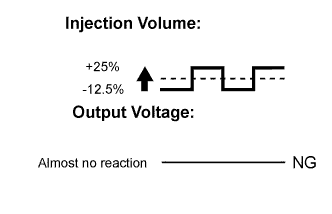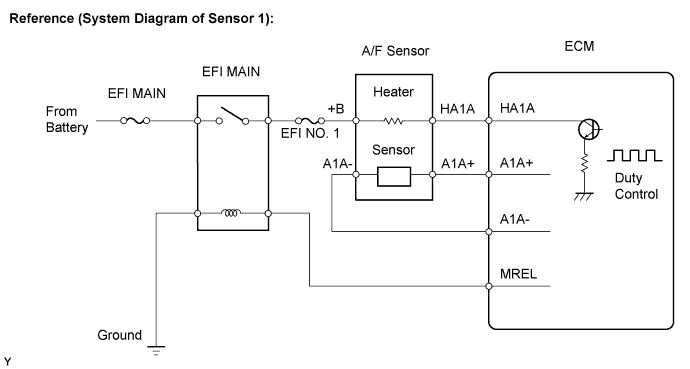CHECK HARNESS AND CONNECTOR (AIR FUEL RATIO SENSOR - ECM)
CHECK WHETHER DTC OUTPUT RECURS (DTC P2237, P2238, P2239, P2252 OR P2253)
DTC P2237 Oxygen (A/F) Sensor Pumping Current Circuit / Open (Bank 1 Sensor 1) |
DTC P2238 Oxygen (A/F) Sensor Pumping Current Circuit Low (Bank 1 Sensor 1) |
DTC P2239 Oxygen (A/F) Sensor Pumping Current Circuit High (Bank 1 Sensor 1) |
DTC P2252 Oxygen (A/F) Sensor Reference Ground Circuit Low (Bank 1 Sensor 1) |
DTC P2253 Oxygen (A/F) Sensor Reference Ground Circuit High (Bank 1 Sensor 1) |
DESCRIPTION
Refer to DTC P2195 (RAV4_ACA30 RM000000WC40H1X_01.html).- HINT:
- Although the DTC titles refer to the oxygen sensor, these DTCs relate to the air fuel ratio sensor.
- Sensor 1 refers to the sensor mounted in front of the three way catalytic converter and located near the engine assembly.
| DTC No. | DTC Detection Condition | Trouble Area |
| P2237 | An open in the circuit between terminals A1A+ and A1A- of the Air Fuel Ratio (A/F) sensor while the engine is running (2 trip detection logic): |
|
| P2238 | One of the following conditions is met (2 trip detection logic):
|
|
| P2239 | The A1A+ voltage is higher than 4.5 V (2 trip detection logic). |
|
| P2252 | The A1A- voltage is 0.5 V or less (2 trip detection logic). |
|
| P2253 | A1A- voltage is higher than 4.5 V (2 trip detection logic). |
|
WIRING DIAGRAM
Refer to DTC P2195 (RAV4_ACA30 RM000000WC40H1X_07.html).INSPECTION PROCEDURE
- HINT:
- Intelligent tester only:
- Malfunctioning areas can be identified by performing the Control the Injection Volume for A/F Sensor function provided in the Active Test. The Control the Injection Volume for A/F Sensor function can help to determine whether the air fuel ratio sensor, heated oxygen sensor and other potential trouble areas are malfunctioning.
- The following instructions describe how to conduct the Control the Injection Volume for A/F Sensor operation using the intelligent tester.
- Connect the intelligent tester to the DLC3.
- Start the engine.
- Turn the tester on.
- Warm up the engine at an engine speed of 2500 rpm for approximately 90 seconds.
- Enter the following menus: Powertrain / Engine and ECT / Active Test / Control the Injection Volume for A/F Sensor.
- Perform the Active Test operation with the engine idling (press the RIGHT or LEFT button to change the fuel injection volume).
- Monitor the output voltages of the air fuel ratio sensor and heated oxygen sensor (AFS Voltage B1S1 and O2S B1S2) displayed on the tester.
- HINT:
- The Control the Injection Volume for A/F Sensor operation lowers the fuel injection volume by 12.5% or increases the injection volume by 25%.
- Each sensor reacts in accordance with increases and decreases in the fuel injection volume.
| Tester Display (Sensor) | Injection Volume | Status | Voltage |
| AFS Voltage B1S1 (Air fuel ratio sensor) | +25% | Rich | Below 3.1 V |
| AFS Voltage B1S1 (Air fuel ratio sensor) | -12.5% | Lean | Higher than 3.4 V |
| O2S B1S2 (Heated oxygen sensor) | +25% | Rich | Higher than 0.55 V |
| O2S B1S2 (Heated oxygen sensor) | -12.5% | Lean | Below 0.4 V |
- NOTICE:
- The air fuel ratio sensor has an output delay of a few seconds and the heated oxygen sensor has a maximum output delay of approximately 20 seconds.
| Case | Air Fuel Ratio Sensor Output Voltage | Heated Oxygen Sensor Output Voltage | Main Suspected Trouble Area |
| 1 |  |  | - |
| 2 |  |  |
|
| 3 |  |  |
|
| 4 |  |  |
|
- Performing the Control the Injection Volume for A/F Sensor enables technicians to check and graph the output voltage of both the air fuel ratio sensor and heated oxygen sensor.
- To display the graph, enter the following menus: Powertrain / Engine and ECT / Active Test / Control the Injection Volume for A/F Sensor / AFS Voltage B1S1 and O2S B1S2.
- HINT:
- Read freeze frame data using the intelligent tester. Freeze frame data records the engine condition when malfunctions are detected. When troubleshooting, freeze frame data can help determine if the vehicle was moving or stationary, if the engine was warmed up or not, if the air fuel ratio was lean or rich, and other data from the time the malfunction occurred.
| 1.CHECK HARNESS AND CONNECTOR (AIR FUEL RATIO SENSOR - ECM) |
Disconnect the air fuel ratio sensor connector.
Disconnect the ECM connector.
Measure the resistance according to the value(s) in the table below.
- Standard Resistance (Check for Open):
Tester Connection Condition Specified Condition B7-3 (A1A+) - B32-112 (A1A+) Always Below 1 Ω B7-4 (A1A-) - B32-113 (A1A-) Always Below 1 Ω
- Standard Resistance (Check for Short):
Tester Connection Condition Specified Condition B7-3 (A1A+) or B32-112 (A1A+) - Body ground Always 10 kΩ or higher B7-4 (A1A-) or B32-113 (A1A-) - Body ground Always 10 kΩ or higher
Reconnect the ECM connector.
Reconnect the air fuel ratio sensor connector.

|
| ||||
| OK | |
| 2.REPLACE AIR FUEL RATIO SENSOR |
Replace the air fuel ratio sensor (RAV4_ACA30 RM000001RO300UX.html).
| NEXT | |
| 3.CHECK WHETHER DTC OUTPUT RECURS (DTC P2237, P2238, P2239, P2252 OR P2253) |
Connect the intelligent tester to the DLC3.
Turn the ignition switch to ON.
Turn the tester on.
Clear the DTCs (RAV4_ACA30 RM000000PDK0AJX.html).
Switch the ECM from normal mode to check mode (RAV4_ACA30 RM000000PDL09HX.html).
Drive the vehicle according to Confirmation Driving Pattern (RAV4_ACA30 RM000000WC40H1X_08.html).
Enter the following menus: Powertrain / Engine and ECT / DTC.
Read the DTCs (Pending DTCs).
Result Result Proceed to DTC is not output A DTC P2237, P2238, P2239, P2252 or P2253 is output B
|
| ||||
| A | ||
| ||